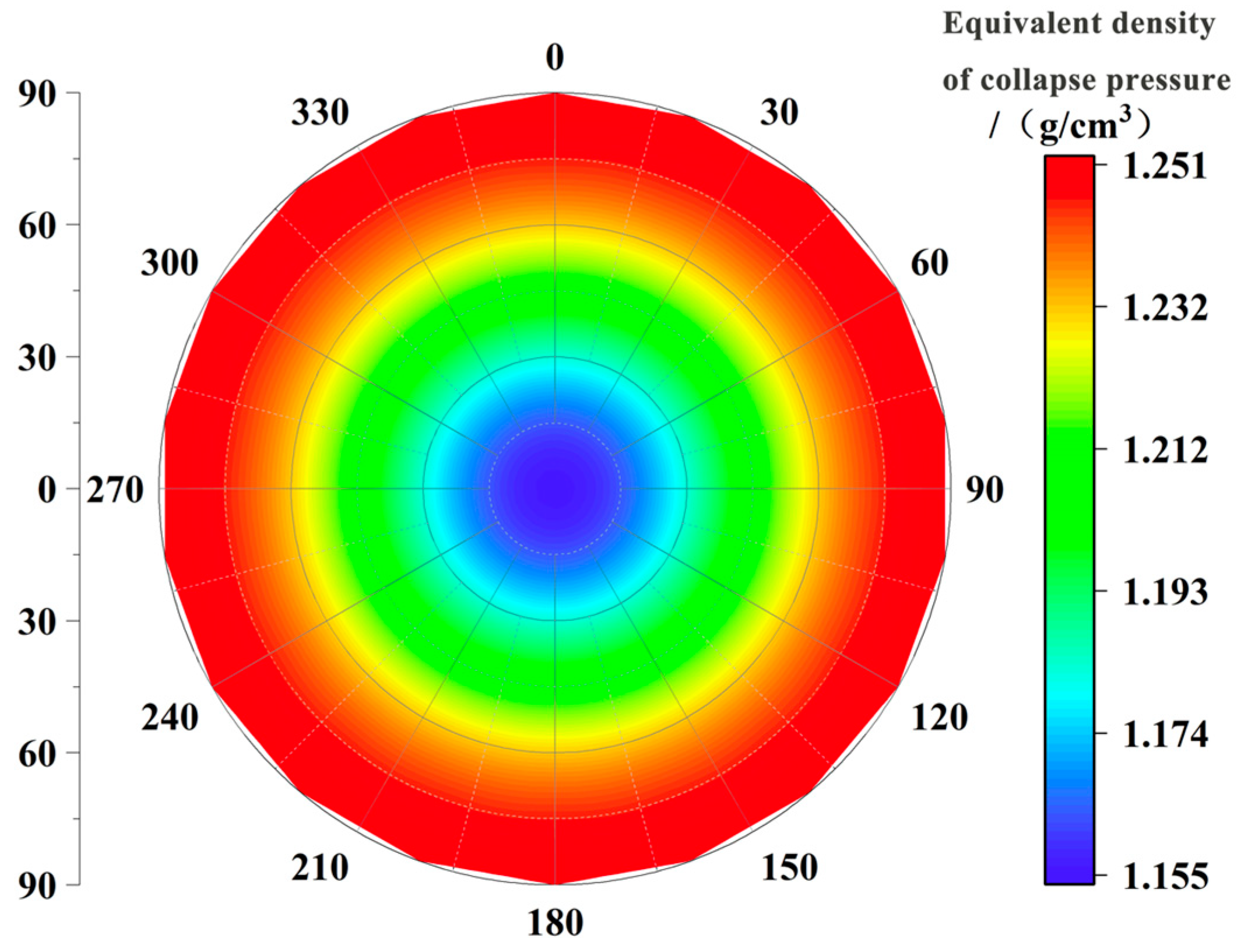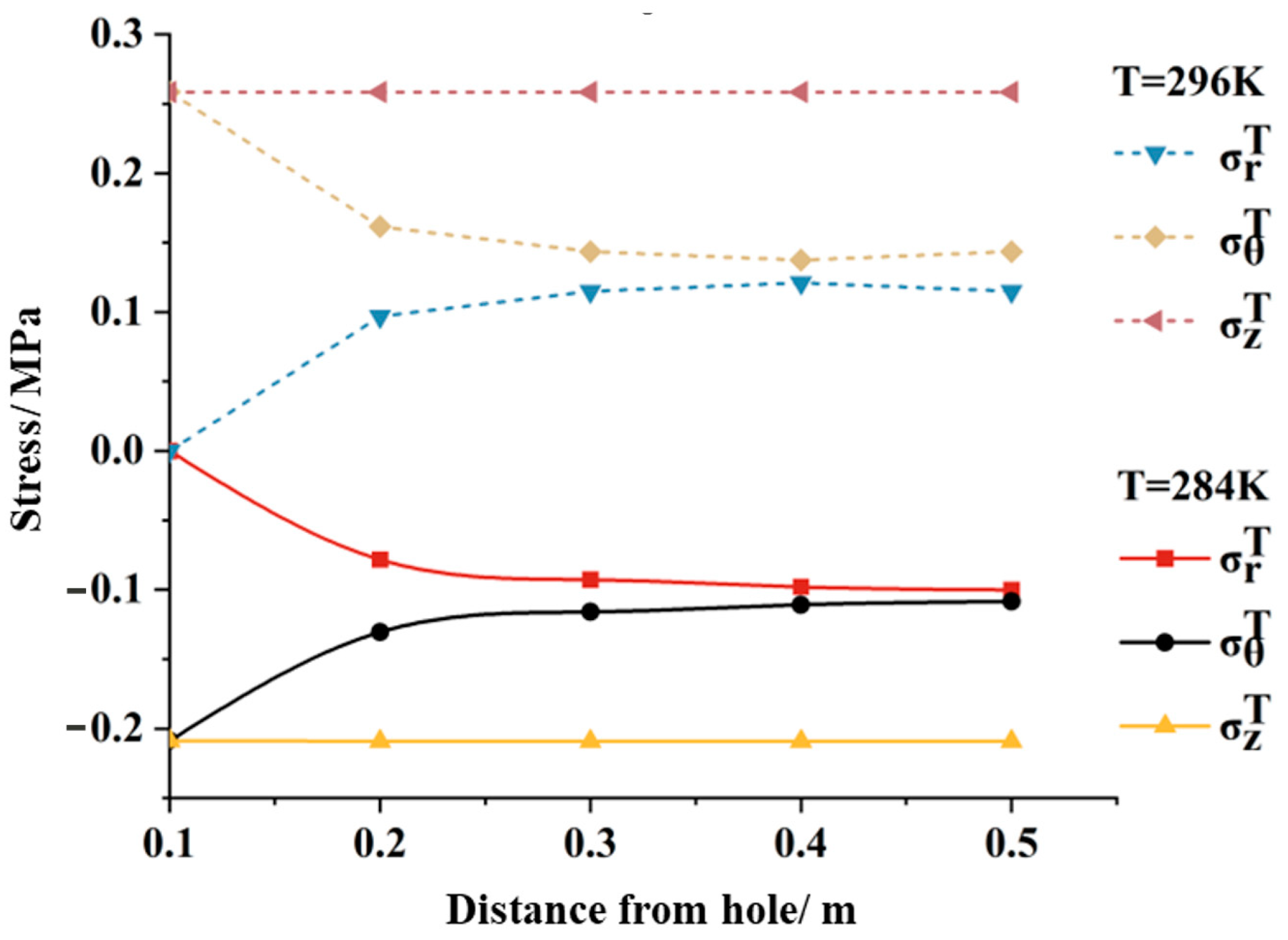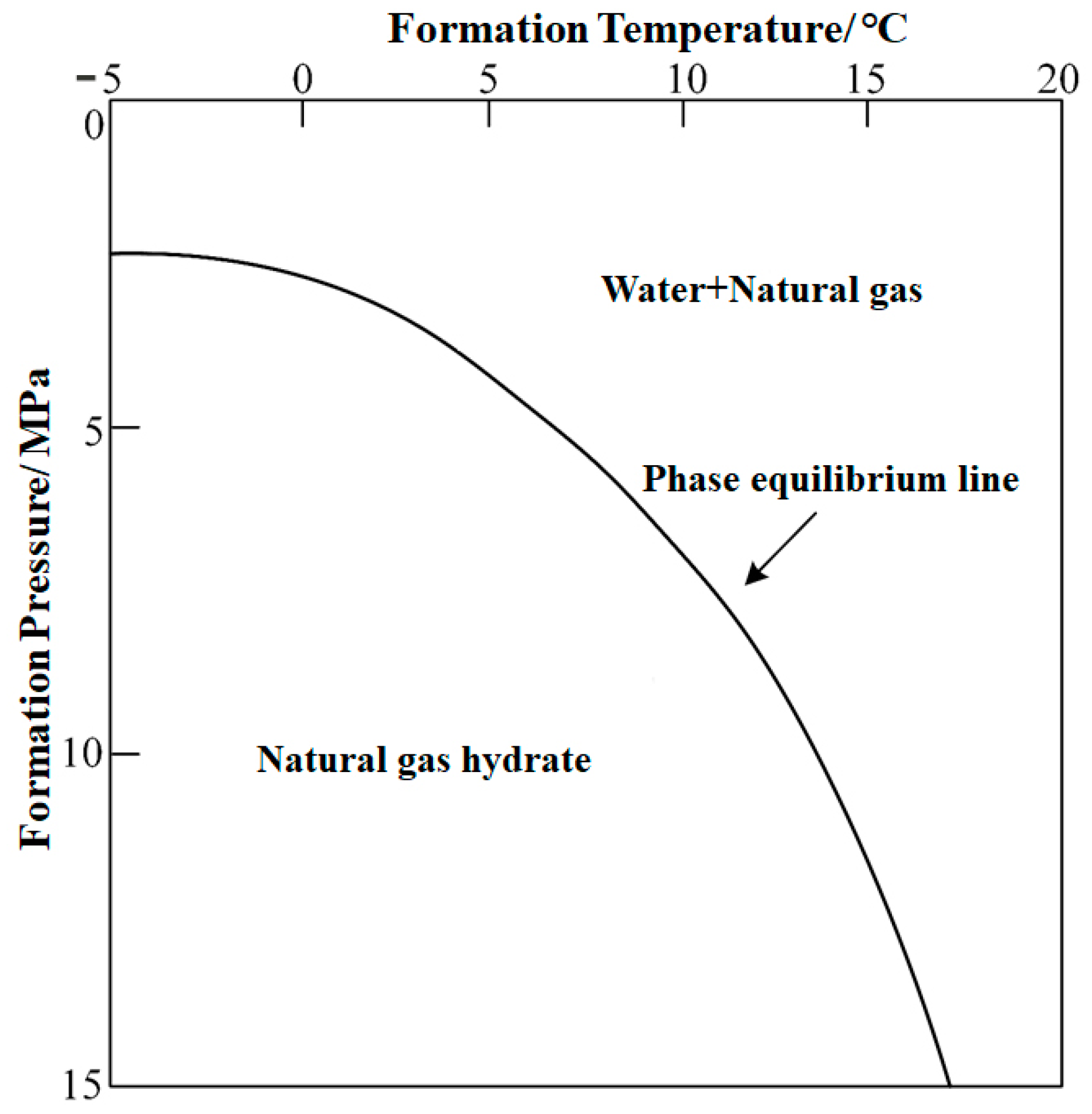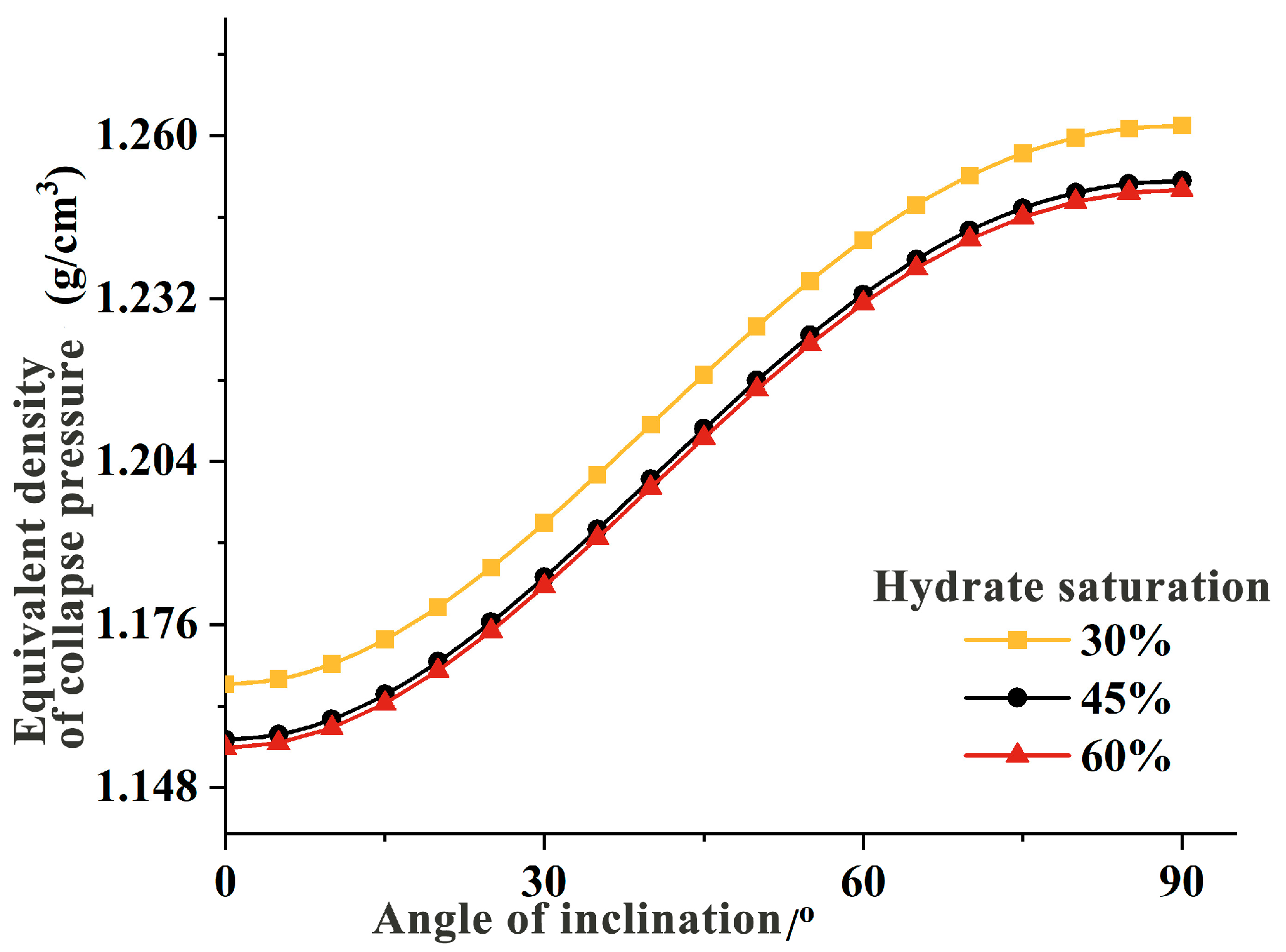Stability Characteristics of Natural Gas Hydrate Wellbores Based on Thermo-Hydro-Mech Modeling
Abstract
:1. Introduction
2. Materials and Methods
2.1. Geostress Model around Gas Hydrate Wells
2.2. Strength Criteria
2.3. Gas Hydrate Reservoir Physical Parameters
2.4. Hydrate Reservoir Petrophysical Parameters
3. Results and Discussion
3.1. Well Deviation Angle and Azimuth Angle
3.2. Drilling Fluid Temperature
3.3. Bottom Hole Pressure
3.4. Formation Porosity
3.5. Hydrate Saturations
4. Conclusions
- (1)
- The transformation from a wellbore coordinate system to geographical and polar coordinates via the Euler transformation facilitated the determination of principal stresses around hydrate formations. This approach integrates factors such as seepage flow, temperature distribution, and stress fields to establish a comprehensive stress model around the wellbore.
- (2)
- When minimum and maximum principal stresses are similar or equal, the azimuth angle has no significant impact on the collapse pressure density of hydrates. Therefore, in designing well trajectories for this formation, it is crucial to focus on the influence of the inclination angle on hydrate wellbore stability. In cases where minimum and maximum principal stresses differ, the stability of hydrate wellbores should be assessed comprehensively considering both inclination and azimuth angles. Specifically, drilling should align with the direction of minimum horizontal stress or perpendicular to the direction of maximum horizontal stress while controlling the variation in the inclination angle within reasonable limits to mitigate the risk of hydrate wellbore collapse.
- (3)
- High-temperature drilling fluids induce thermal stresses in hydrate formations, disrupting stress equilibrium around the wellbore and perturbing hydrate states, thereby increasing the risk of hydrate wellbore instability. Therefore, during drilling operations in hydrate formations, it is advisable to use low-temperature drilling fluids, ideally maintaining drilling fluid temperatures below or at least not exceeding the temperatures of the hydrate formation. This approach not only reduces the risk of hydrate dissociation but also enhances the stability of hydrate formations.
- (4)
- The invasion of drilling fluids can diminish the strength and stability of formations and may react with hydrates within the formation, altering the structure of the formation. This alteration can lead to deformation and fracturing of the formation, posing challenges to wellbore stability. Hence, monitoring changes in bottom hole pressure during drilling is crucial to mitigate damage caused by drilling fluid invasion into hydrate wellbores. The size of formation porosity directly affects hydrate saturation, where higher porosity implies lower hydrate saturation and weaker formation strength. Conversely, lower porosity makes the invasion of drilling fluids more challenging, thereby increasing drilling risks. During the process of hydrate decomposition from high to low saturation, formation strength decreases gradually initially but rapidly later. Therefore, vigilance towards hydrate dissociation during drilling is essential to minimize disturbances to hydrate formations and reduce the risk of wellbore collapse.
Author Contributions
Funding
Data Availability Statement
Conflicts of Interest
References
- Xu, C.; Li, X.; Yan, K.; Ruan, X.; Chen, Z.; Xia, Z. Research Progress in Hydrate-Based Technologies and Processes in China: A Review. Chin. J. Chem. Eng. 2019, 27, 1998–2013. [Google Scholar] [CrossRef]
- Sun, X.; Yao, D.; Qu, J.; Sun, S.; Qin, Z.; Tao, L.; Zhao, Y. A Novel Transient Hole Cleaning Algorithm for Horizontal Wells Based on Drift-Flux Model. Geoenergy Sci. Eng. 2024, 233, 212517. [Google Scholar] [CrossRef]
- Giovannetti, R.; Gambelli, A.M.; Castellani, B.; Rossi, A.; Minicucci, M.; Zannotti, M.; Li, Y.; Rossi, F. May Sediments Affect the Inhibiting Properties of NaCl on CH4 and CO2 Hydrates Formation? An Experimental Report. J. Mol. Liq. 2022, 359, 119300. [Google Scholar] [CrossRef]
- Liu, L.; Sun, Z.; Zhang, L.; Wu, N.; Yichao, Q.; Jiang, Z.; Geng, W.; Cao, H.; Zhang, X.; Zhai, B.; et al. Progress in Global Gas Hydrate Development and Production as a New Energy Resource. Acta Geol. Sin. 2019, 93, 731–755. [Google Scholar] [CrossRef]
- Feng, J.; Yan, T.; Hou, Z. Numerical Simulation Study of Factors Influencing Ultrasonic Cavitation Bubble Evolution on Rock Surfaces during Ultrasonic-Assisted Rock Breaking. Water 2024, 16, 2234. [Google Scholar] [CrossRef]
- Li, G.; Li, X.S.; Lv, Q.N.; Xiao, C.W.; Deng, F.C. Long-Term Analysis of the 2020 Gas Hydrate Production Test in the South China Sea by Full Implicit Simulator of Hydrate. Energy Fuels 2023, 37, 3785–3798. [Google Scholar] [CrossRef]
- Zhong, X.; Pan, D.; Zhai, L.; Zhu, Y.; Zhang, H.; Zhang, Y.; Wang, Y.; Li, X.; Chen, C. Evaluation of the Gas Production Enhancement Effect of Hydraulic Fracturing on Combining Depressurization with Thermal Stimulation from Challenging Ocean Hydrate Reservoirs. J. Nat. Gas Sci. Eng. 2020, 83, 103621. [Google Scholar] [CrossRef]
- Kim, H.C.; Bishnoi, P.R.; Heidemann, R.A.; Rizvi, S.S.H. Kinetics of Methane Hydrate Decomposition. Chem. Eng. Sci. 1987, 42, 1645–1653. [Google Scholar] [CrossRef]
- Yousif, M.H.; Li, P.M.; Selim, M.S.; Sloan, E.D. Depressurization of Natural Gas Hydrates in Berea Sandstone Cores. J. Incl. Phenom. Mol. Recognit. Chem. 1990, 8, 71–88. [Google Scholar] [CrossRef]
- Zhou, S.; Li, Q.; Wei, C.; Zhou, J.; Pang, W.; Yufa, H.; Xin, L.; Xu, L.; Qiang, F.; Jiang, L. The World’s First Successful Implementation of Solid Fluidization Well Testing and Production for Non-Diagenetic Natural Gas Hydrate Buried in Shallow Layer in Deep Water. In Proceedings of the Offshore Technology Conference, Houston, TX, USA, 30 April–3 May 2018; Volume 4, pp. 2784–2794. [Google Scholar] [CrossRef]
- Koh, D.Y.; Kang, H.; Lee, J.W.; Park, Y.; Kim, S.J.; Lee, J.; Lee, J.Y.; Lee, H. Energy-Efficient Natural Gas Hydrate Production Using Gas Exchange. Appl. Energy 2016, 162, 114–130. [Google Scholar] [CrossRef]
- Li, J.; Zhang, Y.; Di, S.; Lin, L.; Zhou, Y. Research on hydrate-bearing reservoir deformation and wellbore wall stability during natural gas hydrate exploitation. Geomech. Energy Environ. 2023, 34, 100458. [Google Scholar] [CrossRef]
- Wang, L.; Li, Y.; Shen, S.; Liu, W.; Sun, X.; Liu, Y.; Zhao, J. Mechanical Behaviours of Gas-Hydrate-Bearing Clayey Sediments of the South China Sea. Environ. Geotech. 2022, 9, 210–222. [Google Scholar] [CrossRef]
- Sun, J.; Ning, F.; Lei, H.; Gai, X.; Sánchez, M.; Lu, J.; Li, Y.; Liu, L.; Liu, C.; Wu, N.; et al. Wellbore Stability Analysis during Drilling through Marine Gas Hydrate-Bearing Sediments in Shenhu Area: A Case Study. J. Pet. Sci. Eng. 2018, 170, 345–367. [Google Scholar] [CrossRef]
- Kurihara, M.; Sato, A.; Funatsu, K.; Ouchi, H.; Yamamoto, K.; Numasawa, M.; Ebinuma, T.; Narita, H.; Masuda, Y.; Dallimore, S.R.; et al. Analysis of Production Data for 2007/2008 Mallik Gas Hydrate Production Tests in Canada. In Proceedings of the International Oil and Gas Conference and Exhibition in China, Beijing, China, 8–10 June 2010; Volume 4, pp. 2908–2931. [Google Scholar] [CrossRef]
- Dong, L.; Liao, H.; Li, Y.; Meng, Q.; Hu, G.; Wang, J.; Wu, N. Analysis of the Mechanical Properties of the Reconstituted Hydrate-Bearing Clayey-Silt Samples from the South China Sea. J. Mar. Sci. Eng. 2022, 10, 831. [Google Scholar] [CrossRef]
- Dong, L.; Wu, N.; Leonenko, Y.; Wan, Y.; Liao, H.; Hu, G.; Li, Y. A coupled thermal-hydraulic-mechanical model for drilling fluid invasion into hydrate-bearing sediments. Energy 2023, 278, 127785. [Google Scholar] [CrossRef]
- Ma, T.; Chen, P.; Yang, C.; Zhao, J. Wellbore Stability Analysis and Well Path Optimization Based on the Breakout Width Model and Mogi-Coulomb Criterion. J. Pet. Sci. Eng. 2015, 135, 678–701. [Google Scholar] [CrossRef]
- Al-Ajmi, A.M.; Zimmerman, R.W. A New Well Path Optimization Model for Increased Mechanical Borehole Stability. J. Pet. Sci. Eng. 2009, 69, 53–62. [Google Scholar] [CrossRef]
- Cheng, W.; Ning, F.; Sun, J.; Liu, Z.; Jiang, G.; Li, X. A Porothermoelastic Wellbore Stability Model for Riserless Drilling through Gas Hydrate-Bearing Sediments in the Shenhu Area of the South China Sea. J. Nat. Gas Sci. Eng. 2019, 72, 103036. [Google Scholar] [CrossRef]
- Ghassemi, A.; Tao, Q.; Diek, A. Influence of Coupled Chemo-Poro-Thermoelastic Processes on Pore Pressure and Stress Distributions around a Wellbore in Swelling Shale. J. Pet. Sci. Eng. 2009, 67, 57–64. [Google Scholar] [CrossRef]
- Birchwood, R.; Noeth, S.; Hooyman, P.; Winters, W.; Jones, E. Wellbore stability model for marine sediments containing gas hydrates. In Proceedings of the AADE National Conference and Exhibition, Houston, TX, USA, 5–7 April 2005. [Google Scholar]
- Freij-Ayoub, R.; Tan, C.; Clennell, B.; Tohidi, B.; Yang, J. A Wellbore Stability Model for Hydrate Bearing Sediments. J. Pet. Sci. Eng. 2007, 57, 209–220. [Google Scholar] [CrossRef]
- Kimoto, S.; Oka, F.; Fushita, T.; Fujiwaki, M. A Chemo-Thermo-Mechanically Coupled Numerical Simulation of the Subsurface Ground Deformations Due to Methane Hydrate Dissociation. Comput. Geotech. 2007, 34, 216–228. [Google Scholar] [CrossRef]
- Chen, Y.; Sun, T.; Zhang, Y.; Chen, Y.; Sun, T.; Zhang, Y.; Qu, X.; Shi, H.; Ying, H. The Suitable Strength Criterion to Determine the Collapse of Hydrate Reservoirs with Different Saturation. In Proceedings of the ISOPE International Ocean and Polar Engineering Conference, Honolulu, HI, USA, 16–21 June 2019. [Google Scholar]
- Khurshid, I.; Lee, K.J.; Bank, J.J.; Choe, J. Heat Transfer and Well Bore Stability Analysis in Hydrate Bearing Zone in the East Sea, South Korea. In Proceedings of the Offshore Technology Conference, Houston, TX, USA, 3–6 May 2010; Volume 2, pp. 1115–1131. [Google Scholar] [CrossRef]
- Qiu, K.; Yamamoto, K.; Birchwood, R.; Chen, Y. Well Integrity Evaluation for Methane Hydrate Production in the Deepwater Nankai Trough. In Proceedings of the International Petroleum Technology Conference, Doha, Qatar, 19–22 January 2014; Volume 1, pp. 822–846. [Google Scholar] [CrossRef]
- Li, L.; Cheng, Y.; Zhang, Y.; Cui, Q.; Zhao, F. A Fluid-Solid Coupling Model of Wellbore Stability for Hydrate Bearing Sediments. Procedia Eng. 2011, 18, 363–368. [Google Scholar] [CrossRef]
- Salehabadi, M.; Jin, M.; Yang, J.; Haghighi, H.; Ahmed, R.; Tohidi, B. Finite Element Modeling of Casing in Gas-Hydrate-Bearing Sediments. SPE Drill. Complet. 2009, 24, 545–552. [Google Scholar] [CrossRef]
- Salehabadi, M.; Jin, M.; Yang, J.; Ahmed, R.; Tohidi, B. The Effect of Casing Eccentricity on the Casing Stability Analysis of a Wellbore Drilled in Gas Hydrate Bearing Sediments. In Proceedings of the SPE EUROPEC/EAGE Annual Conference and Exhibition, Barcelona, Spain, 14–17 June 2010; Volume 3, pp. 2189–2204. [Google Scholar] [CrossRef]
- Guo, Z.Y.; Wang, H.N.; Jiang, M.J. Elastoplastic Analytical Investigation of Wellbore Stability for Drilling in Methane Hydrate-Bearing Sediments. J. Nat. Gas Sci. Eng. 2020, 79, 103344. [Google Scholar] [CrossRef]
- Sun, J.; Ning, F.; Liu, T.; Li, Y.; Lei, H.; Zhang, L.; Cheng, W.; Wang, R.; Cao, X.; Jiang, G. Numerical Analysis of Horizontal Wellbore State during Drilling at the First Offshore Hydrate Production Test Site in Shenhu Area of the South China Sea. Ocean. Eng. 2021, 238, 109614. [Google Scholar] [CrossRef]
- Gao, Y.; Sun, B.; Xu, B.; Wu, X.; Chen, Y.; Zhao, X.; Chen, L. A Wellbore/Formation-Coupled Heat-Transfer Model in Deepwater Drilling and Its Application in the Prediction of Hydrate-Reservoir Dissociation. SPE J. 2017, 22, 756–766. [Google Scholar] [CrossRef]
- Vernik, L.; Zoback, M.D. Estimation of Maximum Horizontal Principal Stress Magnitude from Stress-Induced Well Bore Breakouts in the Cajon Pass Scientific Research Borehole. J. Geophys. Res. Solid Earth 1992, 97, 5109–5119. [Google Scholar] [CrossRef]
- Späth, M.; Herrmann, C.; Prajapati, N.; Schneider, D.; Schwab, F.; Selzer, M.; Nestler, B. Multiphase-Field Modelling of Crack Propagation in Geological Materials and Porous Media with Drucker-Prager Plasticity. Comput. Geosci. 2021, 25, 325–343. [Google Scholar] [CrossRef]
- Holland, G.P.; Jenkins, J.E.; Creager, M.S.; Lewis, R.V.; Yarger, J.L. Solid-State NMR Investigation of Major and Minor Ampullate Spider Silk in the Native and Hydrated States. Biomacromolecules 2008, 9, 651–657. [Google Scholar] [CrossRef]
- Wang, H.N.; Chen, X.P.; Jiang, M.J.; Guo, Z.Y. Analytical Investigation of Wellbore Stability during Drilling in Marine Methane Hydrate-Bearing Sediments. J. Nat. Gas Sci. Eng. 2019, 68, 102885. [Google Scholar] [CrossRef]
- Miyazaki, K.; Tenma, N.; Aoki, K.; Sakamoto, Y.; Yamaguchi, T. Effects of confining pressure on mechanical properties of artificial methane-hydrate-bearing sediment in triaxial compression test. Int. J. Offshore Polar Eng. 2011, 21, 148–154. [Google Scholar]
- Liu, M.; Jin, Y.; Lu, Y.; Chen, M.; Hou, B.; Chen, W.; Wen, X.; Yu, X. A Wellbore Stability Model for a Deviated Well in a Transversely Isotropic Formation Considering Poroelastic Effects. Rock Mech. Rock Eng. 2016, 49, 3671–3686. [Google Scholar] [CrossRef]










| Parameter/Unit | Value | Parameter/Unit | Value |
|---|---|---|---|
| Hole Radius/m | 0.1143 | Hydrate Formation Thermal Expansion Coefficient/K−1 | 7.7 × 10−5 |
| Hole Depth/m | 1420 | Formation Thermal Conductivity/W/(m·K) | 1 |
| Well Deviation Angle/° | 0–90 | Gas Thermal Conductivity/W/(m·K) | 0.07 |
| Well Azimuth Angle/° | 0–90 | Water Thermal Conductivity/W/(m·K) | 0.6 |
| Azimuth Angle/° | 0–360 | Hydrate Thermal Conductivity/W/(m·K) | 2 |
| Overburden Pressure/MPa | 16.4 | Hydrate Initial Saturation/% | 0.5 |
| Maximum Horizontal Principal Stress/MPa | 15.5 | Gas Saturation/% | 0 |
| Minimum Horizontal Principal Stress/MPa | 15.5 | Water Initial Saturation/% | 0.3 |
| Formation Pore Pressure/MPa | 14.3 | Cohesion/MPa | Sh = 0, C = 0.1 |
| Formation Porosity | 0.4 | Internal Friction Angle/° | 30 |
| Drilling Fluid Pressure/MPa | 14.8 | Poisson’s Ratio | 0.35 |
| Drilling Fluid Temperature/K | 290 | Hydrate Elastic Modulus/MPa | Varies with Saturation |
| Formation Temperature/K | 287.15 | Formation Bulk Modulus/GPa | 7 |
| Hydrate Sediment Initial Effective Permeability/μm2 | 0.02 | Biot coefficient | 1 |
Disclaimer/Publisher’s Note: The statements, opinions and data contained in all publications are solely those of the individual author(s) and contributor(s) and not of MDPI and/or the editor(s). MDPI and/or the editor(s) disclaim responsibility for any injury to people or property resulting from any ideas, methods, instructions or products referred to in the content. |
© 2024 by the authors. Licensee MDPI, Basel, Switzerland. This article is an open access article distributed under the terms and conditions of the Creative Commons Attribution (CC BY) license (https://creativecommons.org/licenses/by/4.0/).
Share and Cite
Sun, S.; Zhang, X.; Zhou, Y. Stability Characteristics of Natural Gas Hydrate Wellbores Based on Thermo-Hydro-Mech Modeling. Processes 2024, 12, 2196. https://doi.org/10.3390/pr12102196
Sun S, Zhang X, Zhou Y. Stability Characteristics of Natural Gas Hydrate Wellbores Based on Thermo-Hydro-Mech Modeling. Processes. 2024; 12(10):2196. https://doi.org/10.3390/pr12102196
Chicago/Turabian StyleSun, Shihui, Xiaohan Zhang, and Yunjian Zhou. 2024. "Stability Characteristics of Natural Gas Hydrate Wellbores Based on Thermo-Hydro-Mech Modeling" Processes 12, no. 10: 2196. https://doi.org/10.3390/pr12102196
APA StyleSun, S., Zhang, X., & Zhou, Y. (2024). Stability Characteristics of Natural Gas Hydrate Wellbores Based on Thermo-Hydro-Mech Modeling. Processes, 12(10), 2196. https://doi.org/10.3390/pr12102196






